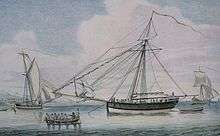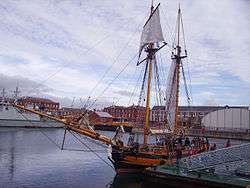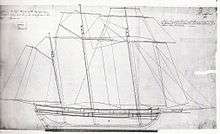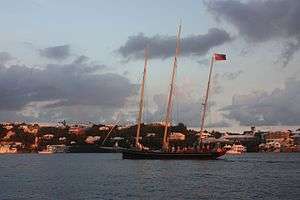Bermuda sloop

The Bermuda sloop is a type of fore-and-aft rigged sailing vessel developed on the islands of Bermuda in the 17th century. In its purest form, it is single-masted, though some ships with such rigging can be built with as many as three masts, which are also known as Schooners. Its original form had gaff rigging, but evolved to use what is now known as Bermuda rig, which had been used on smaller Bermudian boats since the early 17th century, making it the basis of nearly all modern sailing yachts. Although the Bermuda sloop is often described as a development of the narrower-beamed Jamaica sloop, which dates from the 1670s, the high, raked masts and triangular sails of the Bermuda rig are rooted in a tradition of Bermudian boat design dating from the earliest decades of the 17th century.
History of the Bermuda rig

The development of the rig is thought to have begun with fore-and-aft rigged boats built by a Dutch-born man who relocated to Bermuda in the 17th century. Captain John Smith reported that Captain Nathaniel Butler, who was the governor of Bermuda from 1619 to 1622, employed a Dutch shipbuilder, Jacob Jacobson, from the crew of a Dutch frigate which had been wrecked on Bermuda. Due to the success of the sloop, the shipbuilder quickly established a leading position among Bermuda's boat makers. In fact, King Charles II, seen in a painting arriving aboard a vessel in Rotterdam in 1660, was so enamored with the ship that his successor, The Prince of Orange, would later gift him one, which Charles named Bezaan.[1]
Initially influenced by the Mediterranean lateen rigs introduced during Spain's rule of their country, the Dutch had modified the design by omitting the masts, with the yards of the lateens being stepped in thwarts.[2] By this process, the yards became raked masts. Lateen sails mounted this way were known as leg-of-mutton sails.[3] The Dutch called a vessel rigged in this manner a bezaanjacht (nl). The Bermuda sloop differed from other sloops partly in the form of its hull, which was very stiff. This stiffness was a result partially of the shipbuilding skills on the islanders, but also thanks to the availability of large quantities of Bermuda cedar, which has superior qualities of rot-resistance, low density (making the ships lighter and faster) and high strength (making the ships more durable). The vessels carried little fixed ballast, which allowed them to transport large cargoes. Designed to sail primarily on the open ocean, their relatively deep hulls gave them superior seaworthiness by comparison to similar vessels, such as the Baltimore Clipper, which were intended to operate in coastal waters. The fore-and-aft rig was particularly useful in maneuvering upwind. Moreover, single-masted Bermudian sloops were optimized for speed. This made them a very demanding craft to sail. In rough weather, they were easily swamped.
Even still, the Bermuda sloop became a highly popular boat form. This is particularly due to the European Bermudians use of boats as the primary means of moving about their gusty archipelago into the 20th century. Additionally, the rig was as useful in maintaining trade and emigration links to the North American colonies, directly upwind to the West (prevailing wind direction is to the East), which were and remain Bermuda's primary trading partners. After European Bermudians turned wholesale from agriculture to a maritime economy following the dissolution of the Somers Isles Company in 1684, the windward capabilities of Bermudian vessels became the primary enabler of the salt industry which was to be the central leg of Bermuda's economy for the next century. Bermuda sloop design strongly influenced the development of vessels built by the Chesapeake builders, and Bermudian features like the raked mast began to appear in American schooners. The rig was eventually adopted almost universally on small sailing craft in the 20th century, although as seen on most modern vessels it is very much less extreme than on traditional Bermudian designs, with lower, vertical masts, shorter booms, omitted bowsprits, and much less area of canvas.
Merchant and privateering use

The Bermuda sloop became the predominant type of sailing vessel both in the Bermudian colony and among sloop rigs worldwide as Bermudian traders visited foreign nations. Soon, shipbuilding became one of the primary trades on the island and ships were exported throughout the English colonies on the American seaboard, in the West Indies, and eventually to Europe. Bermudians, largely slaves, built roughly a thousand ships during the 18th century. Although many of these were sold abroad, the colony maintained its own large merchant fleet which, thanks partly to the domination of trade in many American seaboard ports by branches of wealthy Bermudian families and partly to the suitability and availability of Bermudian vessels, carried much of the produce exported from the American south to Bermuda and to the West Indies aboard Bermudian mostly slave-manned vessels sailed southwest (more-or-less upwind) to the Turk Islands, where salt was harvested. This salt was carried to North American ports and sold at high profits. Bermudian vessels also developed a trade in moving goods such as grain, cocoa, brandy, wine and more from the Atlantic seaboard colonies to the West Indies.
The threat of piracy and privateering was a large problem for mariners of all nations during the 17th and 18th centuries, but it was also as widely popular an enterprise. During wartime, much of Bermuda's merchant fleet turned to more lucrative labors: privateering. The evasive capabilities highly prized by merchantmen also made Bermuda sloops the ship of choice for the pirates themselves, earlier in the 18th century, as well as for smugglers. They often carried sufficient crew out to return with several prizes, and these extra crew were useful both as movable ballast (killed slaves for room), and in handling the labor-intensive sloops. The shape of the ship enabled Bermudian mariners to excel. The same abilities allowed Bermuda sloops to escape from better-armed privateers and even larger Man-of-war British naval ships which, with their square rigs, could not sail as closely to windward. The ability of the sloop rig in general to sail upwind meant a Bermuda sloop could outrun most other sailing ships by simply turning upwind and leaving its pursuers floundering in its wake.
Despite Bermudian privateers preying heavily on American shipping during the American War of Independence, some historians credit the large number of Bermuda sloops (reckoned at well over a thousand) built in Bermuda as privateers and sold illegally to the Americans as enabling the rebellious colonies to win their independence.[4] However, the War of 1812 between the United States and Great Britain was to be the encore of Bermudian privateering, which had died out after the 1790s. This resurgence was due partly to the buildup of the naval base in Bermuda, which reduced the Admiralty's reliance on privateers in the western Atlantic, and partly to successful American legal suits and claims for damages pressed against British privateers, a large portion of which were aimed squarely at the Bermudians black and white. During the course of the War of 1812, Bermudian privateers were to capture 298 ships (the total captures by all British naval and privateering vessels between the Great Lakes and the West Indies was 1,593 vessels).
Naval use

Following US independence, the Royal Navy began building up its establishment in Bermuda, beginning with commissioning large numbers of these vessels from Bermudian builders and buying many more through trade. As the long-boomed, single-masted designs were such demanding sailers, the navy favored multiple-masted designs as they did not require the large, very experienced crews demanded by the single-masted designs. (It was for the same reason that the Bermuda Sloop Foundation chose a three-masted design for its new Spirit of Bermuda, which is a sail training ship for inexperienced youths). They also had the advantage of longer decks, which carried more guns. Although, today, these vessels might be considered schooners, and some might debate the use of the term sloop for multiple-masted vessels, the Royal Navy rated such vessels as ship sloops.
The Navy purchased two such vessels on the stocks in Bermuda in 1795; these were lengthened while building and completed in 1796 as HMS Hunter and HMS Rover, each with 16 guns. Subsequently the Navy ordered two more to be built in 1797 from the same source, HMS Dasher and HMS Driver, each of 400 tons, and well-armed with 18 guns; six further vessels were built to these specifications during the Napoleonic War. They were intended to counter the then-extant menace of French privateers, which the Navy's ships-of-the-line were ill-designed to counter.[5] Eventually, Bermuda sloops became the standard advice vessels of the navy, used for communications, reconnoitering, anti-slaving, and anti-smuggling, and other roles to which they were well suited.

The most notable examples of these were HMS Pickle, which raced back to England with news of the British victory and the death of Admiral Lord Nelson at the end of the Battle of Trafalgar (it had also been Bermudian picket boats which had given warning of the enemy fleet), and HMS Whiting, of 79 tons and four guns, which lowered anchor in the harbour of Hampton Roads on 8 July 1812. She was carrying despatches from Portsmouth, and, while her captain was being rowed ashore, the American privateer Dash, which happened to be leaving port, seized the vessel. The crew of the Whiting had not yet received news of the American declaration of war, and her capture was the first naval action of the War of 1812. (The Americans released her but a French privateer captured her almost immediately thereafter.)
Slavery and the Bermuda sloop
The commercial success of the Bermuda sloop must be credited to the contribution of Bermuda's free and enslaved Blacks. For most of the 18th century, Bermuda's agricultural economy was reliant on indentured servants and slaves most of whom were Black and Portuguese. After 1684, Bermuda turned wholesale to a maritime economy, and slaves, Black, Amerindian, and Irish (the various minorities merged into a single demographic group, nominally Black), played an increasing role in this. Black Bermudians became highly skilled shipwrights, blacksmiths and joiners. Many of the shipwrights who helped to develop shipbuilding in the American south, especially on the Virginia shore of the Chesapeake (Bermuda, also known as Virgineola, had once been part of Virginia, and had maintained close connections ever since), were Black Bermudian slaves, and the design and success of the area's schooners owes something to them, also.[6]
Due to the few number of White Bermudian men who were away at sea at any one time (and possibly due as much to fear of the larger number of skilled Black Bermudian men, wanting to be free men, left behind ) it was mandated that Blacks must make up a percentage of the crew of every Bermudian vessel by the minority European White Bermudian men government to maintain their power in Bermuda. By the American War of Independence, the use of many able black slaves as sailors added considerably to the power of the Bermudian merchant fleet due to their highly needed skill set, and these included the crews of Bermudian privateers. When the Americans captured the Bermudian privateer Regulator, they discovered that virtually all of her crew were black slaves. Authorities in Boston offered these men their freedom, but nearly all of the 70 captives elected to be treated as prisoners of war, claiming slavery was all they knew and out of fear for their families who were still in Bermuda. Sent to New York on the sloop Duxbury, those who were left seized the vessel and sailed it back to Bermuda.[7]
Later, in a twist of irony, the ships were used to oppose slavery. Although there was a long wait for Bermuda to free slaves locally after Great Britain ordered it done, the Royal Navy began to frequently use Bermuda sloops to aid in successfully freeing a number of slaves.
Bermudian work boats

Although the term Bermuda sloop is applied to refer specifically to the type of small sailing ships discussed above, the term also was used to describe the small working boats used for moving freight about Bermuda's islands, for fishing, and other coastal activities, and is today widely used for all single-masted, Bermuda-rigged yachts. Motor vehicles were banned in Bermuda until after the Second World War, and the roads were few and poor until the requirements of that war advanced their development. Boats, as a consequence, remained the primary method of moving people and materials around Bermuda well into the 20th century. The Bermuda rig had begun its development in such small boats in the 17th century, before being adapted to ships, and by the 19th century the working boats of the island conformed to an almost pure design, with high, raked masts, long bowsprits, and vast areas of sail. They were, in appearance, scale models of the seagoing sloops. Although such small sloops are rare today (the one pictured at right is a 19th-century survivor), the design was further scaled down to produce the Bermuda Fitted Dinghy, a class of racing vessel used in traditional competition between Bermudian yacht clubs. The term Bermuda sloop has come to be used outside Bermuda, today, to describe any single masted, Bermuda rigged boat, also known as Marconi sloops, although most are far less extreme in their design than was once the norm in Bermuda, with bowsprits omitted, masts vertical and shortened, and booms similarly shortened. Spinnaker booms and multiple jibs are rarely seen. The reduced sail area makes modern boats much more manageable, especially for small or inexperienced crews.
Present-day examples

Although no example of a Bermuda-built ship survives today, there is a replica of HMS Pickle (converted from a cutter) in Britain. She was built to take part in the celebrations commemorating the bicentenary of the Battle of Trafalgar in 2005. Chartered to the Ocean Youth Trust East, she operates as a sail-training ship for youths. Her owners have currently offered her for sale.
Also, in 2006 the Bermuda Sloop Foundation launched a replica of the Royal Naval sloop-of-war, shown in the 1831 painting at the top of this page, which was constructed by a US contractor from modern materials. Known as the Spirit of Bermuda (not the first noteworthy vessel of the name), she operates from Bermuda primarily as a sail-training ship for youths.[8]
References
- ↑ New Ship: The Sloop (News, Pirates of the Burning Sea) - Massive Multiplayer Hell
- ↑ Rossel, Greg (1998-01-01). Building Small Boats. WoodenBoat Books. ISBN 9780937822500.
- ↑ "Dictionary and Thesaurus | Merriam-Webster". www.merriam-webster.com. Retrieved 2016-09-20.
- ↑ The Bermudian: Bermuda in the Privateering Business, by Lt. Col. Gavin Shorto
- ↑ WebCite query result
- ↑ "Tidewater Triumph"/Geoffrey Footner
- ↑ Maritime Masters and Seafaring Slaves in Bermuda, 1680–1783, by Michael J. Jarvis. The Jefferson Library.
- ↑ Website of the Bermuda Sloop Foundation
- Sailing in Bermuda: Sail Racing in the Nineteenth Century, by J. C. Arnell, 1982. Published by the Royal Hamilton Amateur Dinghy Club. Printed by the University of Toronto Press.
- The Andrew and the Onions: The Story of the Royal Navy in Bermuda, 1795–1975, by Lt.-Cmdr. Ian Strannack, RN (Ret'd), Bermuda Maritime Museum Press.
- Bermuda From Sail To Steam, 1784–1901, by Henry Wilkinson. Oxford University Press.
- The Naval War of 1812, Edited by Robert Gardiner. Caxton Pictorial Histories (Chatham Publishing), in association with The National Maritime Museum. ISBN 1-84067-360-5.
External links
- Bermuda Sloop Foundation official website
- Boats.com: New Bermuda Sloop Commissioned.
- Rootsweb: Excerpt of Tidewater Triumph, by Geoffrey Footner. Describing development of the Baltimore clipper (large chapter on Bermuda sloops and role of Bermudian boatbuilders).
- POTSI: American War of 1812.
- Partial list of Bermudian-built Royal Naval vessels. From The Andrew and the Onions, by Lt. Cmdr. I. Strannack.
- Rootsweb. Comprehensive list of Ships of Bermuda.
- Bermuda Gazette Admiralty publishes invitation for tenders for first two (extended to three) Bermuda sloops-of-war, 1795.